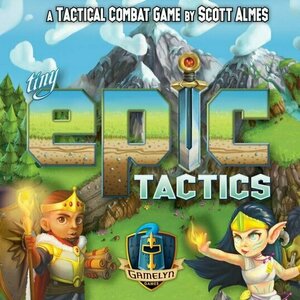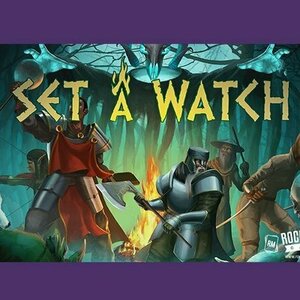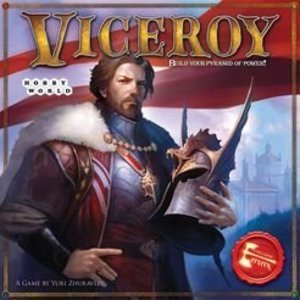
Spades Offline - Single Player
Games
App
Spades Offline - Single Player Card Games is a free version of classic free spades trick-taking card...
Purple Phoenix Games (2266 KP) rated Set a Watch in Tabletop Games
Sep 26, 2019
The kingdom is under attack. Hoards of creatures are amassing at locations around the realm in an attempt to resurrect ancient Unhallowed monsters. Their ultimate goal? To take control of the world. You and your fellow adventurers have been tasked with stopping this uprising. By traveling to these various locations, you will attempt to clear the area of evil-doers and maintain peace in the kingdom. Keep a vigilant watch, and your team will be successful. But if you wane for even a moment, all could be lost.
DISCLAIMER: This review uses the Deluxe version of Set a Watch that we backed on Kickstarter. Some components may differ from components found other versions. -T
Set A Watch is a cooperative game for 1-4 players in which players must secure nine locations around the realm to prevent the release of the deadly Unhallowed monsters. The party always consists of 4 adventurers, regardless of actual player count. In each round, one adventurer will stay back at camp, resting and taking strategic actions, while the other 3 adventurers take watch and fight off the creatures attempting to infiltrate the camp by using special abilities and powers to aid in battle. The game ends in victory if the adventurers have successfully secured all locations. If, at the end of a round, all adventurers on watch are exhausted, the camp is overrun and the game is lost.
So how does solo play differ from multiplayer games? It doesn’t! A solo game of Set A Watch plays identically to a multiplayer game – the solo player just controls all 4 adventurers at once instead of being split up among the players. Obviously, as a solo player, you have to make all of the decisions, which is sometimes nicer than playing with other people. You get to play whatever strategy YOU want to, without having to compromise with other players. On the flip side, that could be treacherous if your strategy is too bold/too meek or if you get in a tight spot and are at a loss for what to do next. Other than the aspect of solo decision-making, the gameplay remains unchanged. One adventurer still rests at camp while the other 3 stand watch and battle monsters.
Typically, I am not a fan of solo games in which you are forced to play multiple characters. That just feels like kind of a cop-out way to say ‘Yeah, we have a solo mode’ when in reality you’re still playing a multiplayer game, just by yourself. That being said, I actually don’t mind this aspect in Set A Watch. Why? Because there really are no ‘turns’ to track. One adventurer stays at camp and acts first, but the other 3 go to battle and act whenever/however they want. There is no real turn order. I make the characters act when and how I want them to, and that really opens the rounds up to a lot of freedom. I don’t have to sacrifice special powers/abilities because it wasn’t that character’s ‘turn’ – I can come up with some sweet combos, utilizing whichever characters I need to, to really do some damage. The lack of turns makes this a truly cooperative game, even when playing solo.
Overall, I love Set A Watch. It was, admittedly, a little intimidating at first, but once I got the hang of it, it plays great! The components are nice and sturdy, the box transforms into the game board, and the artwork is very nicely done. Set A Watch is a game I would definitely play either multiplayer or solo, and not as a last resort. The gameplay is engaging, the strategic options give you a different game every play, and the theme itself is just exciting to me. I am very happy with this Kickstarter purchase, and I look forward to any expansions/reimplementations that could be in the works!
Ryan Lick (16 KP) rated Root in Tabletop Games
Jul 21, 2019

Tiny Epic Tactics
Tabletop Game
Tiny Epic Tactics utilizes a simple combat system with variable player powers and 3-D terrain to...

Tiny Armies
Games
App
Epic battles of tiny proportions! Tiny Armies is a fast-paced game of conquest. Simply swipe your...

Scorch
Book
A touching and provocative story of first love though the eyes of a gender-curious teen, Scorch was...

Real Guitar - Play Chords, Tabs & Simulator Games
Music and Entertainment
App
From now on all you need to play guitar is your iPhone or iPad and the #1 guitar playing app - Real...
Purple Phoenix Games (2266 KP) rated Viceroy in Tabletop Games
Jun 12, 2019
Power. That’s what everyone wants, isn’t it? Well, at least it is in Viceroy! As an inhabitant of the world of Laar, you are fighting to become the ultimate ruler. Recruit allies who provide strategic advantages and enact laws that solidify your claim for power. Do you have what it takes to build and maintain a powerful kingdom, or will your attempts fall short?
DISCLAIMER: There is an expansion to this game, but we are not reviewing it at this time. Should we review it in the future we will either update this review or post a link to the new material here. -T
Viceroy, a game of card drafting and tile placement, is played over 12 turns in which players build a pyramid with their cards – paying to place each card and collecting rewards based upon which level of the pyramid a card is placed. Each turn is divided into two phases: Auction and Development. During the Auction Phase, players bid gemstones to buy a card from the auction line. Once every player has either collected 1 card from auction or passed, play moves to the Development Phase. During the Development Phase, players can either play a card into their pyramid, pass, or discard a card and take 2 gemstones from the reserve. To play a Law card into your pyramid, you place it for free. To play a Character card into your pyramid, you have to pay for it with gems. The cost is dependent upon which level of the pyramid the card is to be placed. You must pay for the level the card will sit on, as well as pay the cost for every level beneath it. For example, to add a card to the third level of the pyramid, you must pay the cost for the 3rd level, AND 2nd level, AND 1st level. The rewards gained from adding a card to the pyramid, however, are taken only for the level on which the card sits. In the earlier example, you would only get the reward for the third level alone, since that is the level on which the card sits. The Development Phase is played over 3 rounds, so a player could play up to 3 cards into their pyramid during 1 Development Phase. After the 3 rounds are up, the next turn begins again in the Auction Phase. When all cards are gone from the Auction Deck, the game ends. Players count up all of their Power Points, and the player with the highest Power value wins!
The only change in Viceroy between a group and solo game is during the Auction Phase. Obviously, if you are playing solo, there is nobody to bid against for cards. How that is alleviated is that you still bid your gemstone as normal, and you randomly draw an unused gemstone from the box as an AI bid. If the colors match, you lose your gem and go on to the next auction. If the colors do not match, you collect your choice card, and the card the AI would have collected gets discarded. If the AI color does not match an available card, you just discard one of the remaining cards. This mimics group play in the sense that you might not always get the card you want from auction! The Development Phase is played as normal. At the end of the game, count points as normal and try to beat your own high score.
Viceroy is a neat game. Every card has so many options that there is no one single strategy that is a sure-win every time. Maybe one game I’ll go for Magic tokens. And maybe the next I’ll try to go for raw Power Point tokens. The possibilities really are endless, and that keeps this game fresh for me. I don’t feel like I’m just going through the motions because every card will act differently depending on where it is played. Strategy really is everything here. On the flip-side of that, however, is that sometimes the options can be a little overwhelming. With so many possibilities for each card, it can get hard for me to decide on what strategy I really want to use. It should also be noted that a card can only be played onto a level if it can sit on exactly 2 cards on the level beneath it. So sometimes I buy a card to play on a certain level only to get to the Development Phase and realize I don’t have a legal place to which I can play it. So do I sacrifice other cards/gemstones to build a slot for this one card, or do I play it to a different level and change my strategy a bit? There’s a little bit of a learning curve, but the more I play, the better I get (or at least, the better I think I get).
Another grievance with Viceroy is that I find myself running out of cards in my hand a lot. The only opportunity to draw cards is if you play a card into your pyramid that allows you to do so. And since I’m usually focused on other strategic routes, I don’t use those cards for those purposes. So then I play all of the cards in my hand (leaving me empty-handed), get 1 card at the next auction, play it, and am again left with no cards in my hand. To fix this issue, I wish one of the actions you could take during the Development Phase was to draw 1 card. I’m not sure if other people have this issue, or if it’s just me, but it’s a problem I run into almost every game.
Overall, I think Viceroy is a good game. It’s unique in the sense that there are so many possibilities that you’ll probably never play the same game twice, even if you decide to play by the same strategy. The mechanics and gameplay are cool too – it’s fun to watch your pyramid literally grow in front of you as the game progresses. This game takes a little more focus and thought than you might think, so it’s not one I’d necessarily just pull out for some light fun. I think Viceroy is as exciting as a solo game as it is as a group game since there really aren’t any differences between the two settings. If you like Viceroy, give it a try solo! If you’ve never played Viceroy, try it either solo or in a group – it’s the same game after all!
https://purplephoenixgames.wordpress.com/2019/04/18/solo-chronicles-viceroy/

Electric Guitar Lessons - Ultimate Guide
Music and Education
App
This app has over 300 easy to follow video lessons on how to play the Electric Guitar including...

Just Food Fun
Education, Games and Stickers
App
PLAY, LEARN, SHARE You are what you eat, so why not play with your food? Just Food Fun is the...


